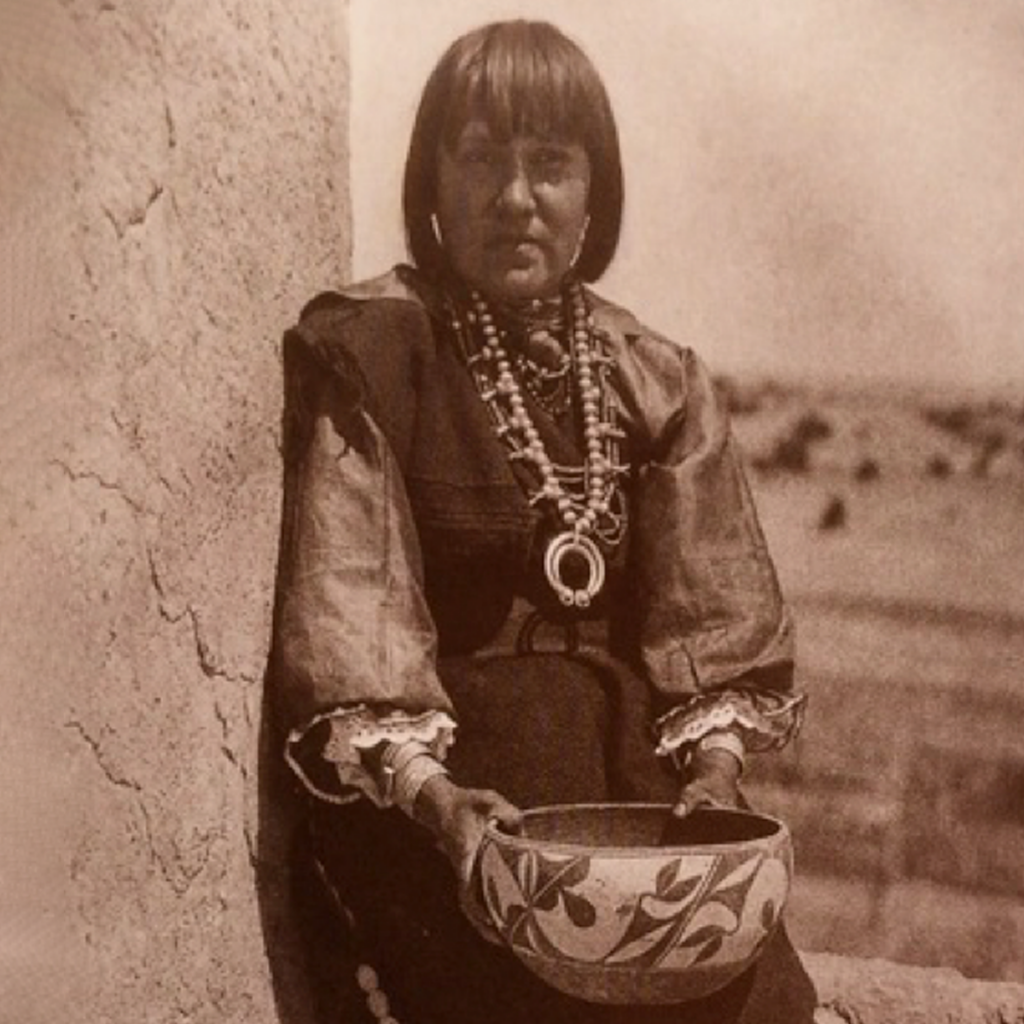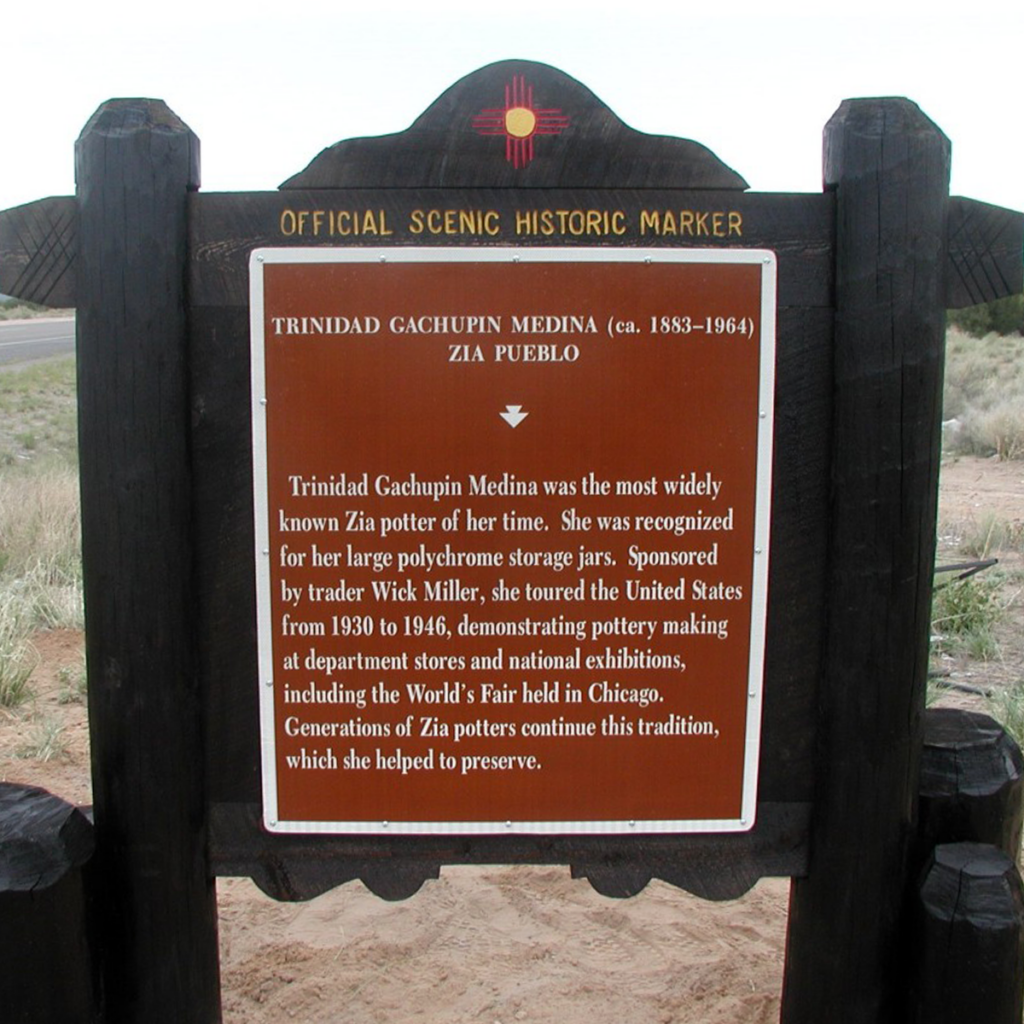Trinidad Gachupin Medina
1883 - 1964
Sandoval County
One of the most notable Zia potters of her generation and arguably in the history of Zia pottery, she traveled throughout the United States introducing non-Indians to the arts and culture of her community and Pueblo culture in general. Her elaborate designs won numerous prizes at the Santa Fe Indian Market.
Trinidad Gachupin Medina was the most recognized Zia potter of her time. Known for her large polychrome storage jars and impressive designs, she traveled outside of her village to demonstrate pottery making at numerous venues throughout the United States. Her presentations and evangelism helped make Zia pottery and Pueblo culture visible outside of New Mexico.
Zia is a Keresan-speaking pueblo in north-central New Mexico. The pueblo has a long tradition of making pottery and has relied on the craft as an important source of income. Zia pottery had been a popular trade item at Jemez, Santa Ana, and San Felipe, valued for its practical usage as water and storage jars. With the growth of the tourist industry in the late nineteenth century, Zia pottery became popular among tourists. In the early 1900s, influenza and smallpox struck the village, and the community relied on goods and proceeds from the trade and sale of pottery to stave off starvation.
The Bureau of Ethnology, under the support of the Smithsonian Institution from 1881 to 1887, and the American Museum of Natural History from 1899 to 1911, collected hundreds of examples of Zia pottery. While similar to the pottery of Acoma, Zia ware is thicker walled. Zia pots are generally polychrome with red and black designs on a cream-colored background, and feature a host of decorative elements including deer, birds, flowers, and geometric designs. The base of Zia pots are typically red with an encircling band separating the base from the designs.
Trinidad was the daughter of Jesse Gachupin and Lucia Salas Gachupin. She married José de la Cruz Medina and they had one child. Trinidad Medina’s extensive travels pushed the potter and her works into the spotlight. Prior to 1900, individual Zia potters remained largely anonymous. Sponsored by trader Wick Miller, Medina toured the United States from 1930 to 1946 demonstrating pottery making at department stores and national exhibitions, including the Century of Progress Exposition in Chicago in 1933 and likely the San Francisco Golden Gate International Exhibition in 1939. Photographs from one of these demonstrations show Medina positioned at a distance from observers and surrounded by railing, a setup that she described as making her feel “like a cow in a corral.” Like other Pueblo artists—such as world famous San Ildefonso potter Maria Martinez, who traveled to similar events during the same time period—Medina acted as an ambassador introducing non-Indians to the arts and culture of her community, and Pueblo culture in general.
Medina’s elaborate designs included bird, flower, and rainbow designs and motifs, and geometric patterns. It is said that Medina developed the “skyscraper” design after seeing skyscrapers while visiting cities back east; evidence suggests otherwise, though, as similar motifs appeared on Zia pottery prior to Medina’s travels. Most of Medina’s works are unsigned. Several of her pots remain in the School of American Research collection in Santa Fe, New Mexico. She won numerous prizes at the Santa Fe Indian Market. Medina’s demonstrations and her talent as a potter, made her one of the most notable Zia potters of her generation and arguably in the history of Zia pottery.
Sources:
Barry, John W. American Indian Pottery: An Identification Guide. 2d. Ed. Florence, Ala.: Books Americana, 1984.
Harlow, Francis H. and Dwight P. Lanmon. The Pottery of Zia Pueblo. Santa Fe:School of American Research Press, 2003.
Schaaf, Gregory. Southern Pueblo Pottery: 2,000 Artist Biographies. American Indian Art Series. Santa Fe:CIAC Press, 2002.
Directions:
Trinidad Gachupin Medina
Sandoval County
Artist | Cultural preservationist |
Statehood (1912 - present) | Territorial Period (1848 - 1912) |
Central








